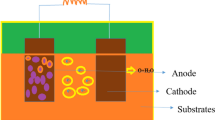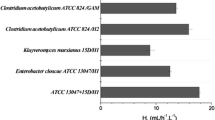Abstract
Carbon monoxide (CO) is one of the main waste gas components of the steel industry and biomass gasification process. CO has also been highlighted as a feedstock for biological conversion to platform and valueadded chemicals. Conventional CO-converting strains have drawbacks of slow growth rate and high sensitivity to oxygen as well as low conversion yield. Most CO conversion microbes harbor the Wood-Ljungdahl pathway (WLP) and CO-dehydrogenase, and the reducing equivalent is significantly limited for acetyl-CoA synthesis. In this study, electrochemically active CO converting strains were isolated and characterized using zero valent iron (ZVI) granules (Fe0) as an external electron donor. The strains isolated from ZVI augmented enrichment could also use a carbon electrode as the electron donor, and simultaneously convert CO to acetate and VFAs in a bioelectrochemical system. From enrichment and isolation with ZVI, both Clostridium sp. HN02 and Fonticella sp. HN43 were isolated and showed higher performance for acetate production from CO in BES, and electrochemical activity by cyclic voltammetry.
Similar content being viewed by others
References
Clomburg, J. M., A. M. Crumbley, and R. Gonzalez (2017) Industrial biomanufacturing: The future of chemical production. Science 355.
Nielsen, D. U., X.-M. Hu, K. Daasbjerg, and T. Skrydstrup (2018) Chemically and electrochemically catalysed conversion of CO2 to CO with follow-up utilization to value-added chemicals. Nature Catalysis 1: 244–254.
Sipma, J., A. Henstra, S. Parshina, P. N. L. Lens, G. Lettinga, and A. J. M. Stams (2008) Microbial CO Conversions with Applications in Synthesis Gas Purification and Bio-Desulfurization.
Feaster, J. T., C. Shi, E. R. Cave, T. Hatsukade, D. N. Abram, K. P. Kuhl, C. Hahn, J. K. Nørskov, and T. F. Jaramillo (2017) Understanding selectivity for the electrochemical reduction of carbon dioxide to formic acid and carbon monoxide on metal electrodes. ACS Catalysis 7: 4822–4827.
Geelhoed, J. S., A. M. Henstra, and A. J. M. Stams (2016) Carboxydotrophic growth of Geobacter sulfurreducens. Applied Microbiology and Biotechnology 100: 997–1007.
Humphreys, C. M. and N. P. Minton (2018) Advances in metabolic engineering in the microbial production of fuels and chemicals from C1 gas. Current Opinion in Biotechnology 50: 174–181.
Berg, I. A. (2011) Ecological aspects of the distribution of different autotrophic CO2 fixation pathways. Applied and Environmental Microbiology 77: 1925–1936.
Costa Gomes, M. F. (2007) Low-pressure solubility and thermodynamics of solvation of carbon dioxide, ethane, and hydrogen in 1-hexyl-3-methylimidazolium bis(trifluoromethylsulfonyl)amide between temperatures of 283 K and 343 K. Journal of Chemical & Engineering Data 52: 472–475.
Nichols, N., B. Dien, and R. Bothast (2001) Use of catabolite repression mutants for fermentation of sugar mixtures to ethanol. Applied Microbiology and Biotechnology 56: 120–125.
Sahu, A. K., J. Siljudalen, T. Trydal, and B. Rusten (2013) Utilisation of wastewater nutrients for microalgae growth for anaerobic codigestion. Journal of Environmental Management 122: 113–120.
Choi, O., T. Kim, H. M. Woo, and Y. Um (2014) Electricity-driven metabolic shift through direct electron uptake by electroactive heterotroph Clostridium pasteurianum. Scientific Reports 4: 6961.
Han, S., X.-Y. Gao, H.-J. Ying, and C. C. Zhou (2016) NADH gene manipulation for advancing bioelectricity in Clostridium ljungdahlii microbial fuel cells. Green Chemistry 18: 2473–2478.
Im, C., Y. E. Song, B.-H. Jeon, and J. R. Kim (2016) Biologically activated graphite fiber electrode for autotrophic acetate production from CO2 in a bioelectrochemical system.
Im, C. H., C. Kim, Y. E. Song, S.-E. Oh, B.-H. Jeon, and J. R. Kim (2018) Electrochemically enhanced microbial CO conversion to volatile fatty acids using neutral red as an electron mediator. Chemosphere 191: 166–173.
Jourdin, L., S. M. T. Raes, C. J. N. Buisman, and D. P. B. T. B. Strik (2018) Critical biofilm growth throughout unmodified carbon felts allows continuous bioelectrochemical chain elongation from CO2 up to caproate at high current density. Frontiers in Energy Research 6.
Kim, C., S. K. Ainala, Y.-K. Oh, B.-H. Jeon, S. Park, and J. R. Kim (2016) Metabolic flux change in Klebsiella pneumoniae L17 by anaerobic respiration in microbial fuel cell. Biotechnology and Bioprocess Engineering 21: 250–260.
Najafpour, G. and H. Younesi (2006) Ethanol and acetate synthesis from waste gas using batch culture of Clostridium ljungdahlii. Enzyme and Microbial Technology 38: 223–228.
Zhu, H., B. H. Shanks, and T. J. Heindel (2008) Enhancing CO−water mass transfer by functionalized MCM41 nanoparticles. Industrial & Engineering Chemistry Research 47: 7881–7887.
Batlle-Vilanova, P., S. Puig, R. Gonzalez-Olmos, M. D. Balaguer, and J. Colprim (2016) Continuous acetate production through microbial electrosynthesis from CO2 with microbial mixed culture. Journal of Chemical Technology & Biotechnology 91: 921–927.
Batlle-Vilanova, P., S. Puig, R. Gonzalez-Olmos, A. Vilajeliu-Pons, M. D. Balaguer, and J. Colprim (2015) Deciphering the electron transfer mechanisms for biogas upgrading to biomethane within a mixed culture biocathode. RSC Advances 5: 52243–52251.
Bajracharya, S., R. Yuliasni, K. Vanbroekhoven, C. J. N. Buisman, D. P. B. T. B. Strik, and D. Pant (2017) Long-term operation of microbial electrosynthesis cell reducing CO2 to multi-carbon chemicals with a mixed culture avoiding methanogenesis. Bioelectrochemistry 113: 26–34.
Raghavulu, S. V., P. S. Babu, R. K. Goud, G. V. Subhash, S. Srikanth, and S. V. Mohan (2012) Bioaugmentation of an electrochemically active strain to enhance the electron discharge of mixed culture: process evaluation through electro-kinetic analysis. RSC Advances 2: 677–688.
Bajracharya, S., A. ter Heijne, X. Dominguez Benetton, K. Vanbroekhoven, C. J. N. Buisman, D. P. B. T. B. Strik, and D. Pant (2015) Carbon dioxide reduction by mixed and pure cultures in microbial electrosynthesis using an assembly of graphite felt and stainless steel as a cathode. Bioresource Technology 195: 14–24.
Abrini, J., H. Naveau, and E.-J. Nyns (1994) Clostridium autoethanogenum, sp. nov., an anaerobic bacterium that produces ethanol from carbon monoxide.
DSMZ. https://www.dsmz.de/microorganisms/medium/pdf/DSMZ_ Medium141.pdf.
Levy, P. F., G. W. Barnard, D. V. Garcia-Martinez, J. E. Sanderson, and D. L. Wise (1981) Organic acid production from CO2/H2 and CO/H2 by mixed-culture anaerobes. Biotechnology and Bioengineering 23: 2293–2306.
Lane, D. J., B. Pace, G. J. Olsen, D. A. Stahl, M. L. Sogin, and N. R. Pace (1985) Rapid determination of 16S ribosomal RNA sequences for phylogenetic analyses. Proceedings of the National Academy of Sciences 82: 6955–6959.
Tamura, K. and M. Nei (1993) Estimation of the number of nucleotide substitutions in the control region of mitochondrial DNA in humans and chimpanzees. Molecular Biology and Evolution 10: 512–526.
Tamura, K., D. Peterson, N. Peterson, G. Stecher, M. Nei, and S. Kumar (2011) MEGA5: Molecular Evolutionary Genetics Analysis Using Maximum Likelihood, Evolutionary Distance, And Maximum Parsimony Methods.
Bryant, M. P. (1972) Commentary on the Hungate technique for culture of anaerobic bacteria. The American Journal of Clinical Nutrition 25: 1324–1328.
Carlson, E. D. and E. T. Papoutsakis (2017) Heterologous Expression of the Clostridium Carboxidivorans CO Dehydrogenase Alone or Together with the Acetyl Coenzyme A Synthase Enables both Reduction of CO2 and Oxidation of CO by Clostridium acetobutylicum. Applied and Environmental Microbiology 83: e00829–00817.
Mock, J., Y. Zheng, A. P. Mueller, S. Ly, L. Tran, S. Segovia, S. Nagaraju, M. Köpke, P. Dürre, and R. K. Thauer (2015) energy conservation associated with ethanol formation from H2 and CO2 in Clostridium autoethanogenum involving electron bifurcation. Journal of Bacteriology 197: 2965–2980.
Lee, J. H., S. Lama, J. R. Kim, and S. H. Park (2018) Production of 1,3-propanediol from glucose by recombinant Escherichia coli BL21(DE3). Biotechnology and Bioprocess Engineering 23: 250–258.
Lee, H.-M., B.-Y. Jeon, and M.-K. Oh (2016) Microbial production of ethanol from acetate by engineered Ralstonia eutropha. Biotechnology and Bioprocess Engineering 21: 402–407.
Kim, C., M. Y. Kim, I. Michie, B.-H. Jeon, G. C. Premier, S. Park, and J. R. Kim (2017) Anodic electro-fermentation of 3-hydroxypropionic acid from glycerol by recombinant Klebsiella pneumoniae L17 in a bioelectrochemical system. Biotechnology for Biofuels 10: 199.
Author information
Authors and Affiliations
Corresponding author
Electronic supplementary material
Rights and permissions
About this article
Cite this article
Im, H.S., Kim, C., Song, Y.E. et al. Isolation of Novel CO Converting Microorganism Using Zero Valent Iron for a Bioelectrochemical System (BES). Biotechnol Bioproc E 24, 232–239 (2019). https://doi.org/10.1007/s12257-018-0373-7
Received:
Revised:
Accepted:
Published:
Issue Date:
DOI: https://doi.org/10.1007/s12257-018-0373-7




